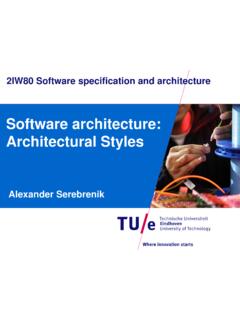Transcription of An Introduction to Software Architecture
1 An Introduction to Software Architecture David Garlan and Mary Shaw January 1994. CMU-CS-94-166. School of Computer Science Carnegie Mellon University Pittsburgh, PA 15213-3890. Also published as An Introduction to Software Architecture , Advances in Software Engineering and Knowledge Engineering, Volume I, edited by and , World Scientific Publishing Company, New Jersey, 1993. Also appears as CMU Software Engineering Institute Technical Report CMU/SEI-94-TR-21, ESC-TR-94-21. 1994 by David Garlan and Mary Shaw This work was funded in part by the Department of Defense Advanced Research Project Agency under grant MDA972-92-J-1002, by National Science Foundation Grants CCR-9109469 and CCR-9112880, and by a grant from Siemens Corporate Research. It was also funded in part by the Carnegie Mellon University School of Computer Science and Software Engineering Institute (which is sponsored by the Department of Defense). The views and conclusions contained in this document are those of the authors and should not be interpreted as representing the official policies, either expressed or implied, of the Government, the Department of Defense, the National Science Foundation, Siemens Corporation, or Carnegie Mellon University.
2 Keywords: Software Architecture , Software design, Software engineering Abstract As the size of Software systems increases, the algorithms and data structures of the computation no longer constitute the major design problems. When systems are constructed from many components, the organization of the overall system the Software Architecture presents a new set of design problems. This level of design has been addressed in a number of ways including informal diagrams and descriptive terms, module interconnection languages, templates and frameworks for systems that serve the needs of specific domains, and formal models of component integration mechanisms. In this paper we provide an Introduction to the emerging field of Software Architecture . We begin by considering a number of common architectural styles upon which many systems are currently based and show how different styles can be combined in a single design. Then we present six case studies to illustrate how architectural representations can improve our understanding of complex Software systems.
3 Finally, we survey some of the outstanding problems in the field, and consider a few of the promising research directions. Contents 1. Introduction .. 2. 2. From Programming Languages to Software 3. High-level Programming Languages .. 3. Abstract Data 4. Software Architecture .. 4. 3. Common architectural 5. Pipes and Filters .. 6. Data Abstraction and Object-Oriented Organization .. 8. Event-based, Implicit Invocation .. 9. Layered Systems .. 11. 12. Table Driven Interpreters .. 13. Other Familiar 14. Heterogeneous 15. 4. Case 16. Case Study 1: Key Word in Context .. 16. Case Study 2: Instrumentation Software .. 22. Case 3: A Fresh View of 26. Case 4: A Layered Design with Different Styles for the Layers .. 28. Case 5: An Interpreter Using Different Idioms for the 30. Case 6: A Blackboard Globally Recast as Interpreter .. 33. 5. Past, Present, and Future .. 36. 37. Bibliography .. 37. List of Figures 1 Pipes and Filters.
4 7. 2 Abstract Data Types and 8. 3 Layered Systems .. 11. 4 The 13. 5 14. 6 KWIC - Shared Data 18. 7 KWIC - Abstract Data Type 19. 8 KWIC - Implicit Invocation Solution .. 20. 9 KWIC - Pipe and Filter Solution .. 20. 10 KWIC - Comparison of 21. 11 Oscilloscopes - An Object-oriented 23. 12 Oscilloscopes - A Layered Model .. 24. 13 Oscilloscopes - A Pipe and Filter 24. 14 Oscilloscopes - A Modified Pipe and Filter 25. 15 Traditional Compiler 26. 16 Traditional Compiler Model with Shared Symbol Table .. 26. 17 Modern Canonical Compiler .. 27. 18 Canonical Compiler, 27. 19 PROVOX - Hierarchical Top 28. 20 PROVOX - Object-oriented Elaboration .. 29. 21 Basic Rule-Based 31. 22 Sophistocated Rule-Based 32. 23 Simplified Rule-Based 33. 24 34. 25 Blackboard View of 35. 26 Interpreter View of Hearsay-II .. 36. Garlan & Shaw: An Introduction to Software Architecture 1. 1. Introduction As the size and complexity of Software systems increases, the design problem goes beyond the algorithms and data structures of the computation: designing and specifying the overall system structure emerges as a new kind of problem.
5 Structural issues include gross organization and global control structure;. protocols for communication, synchronization, and data access; assignment of functionality to design elements; physical distribution; composition of design elements; scaling and performance; and selection among design alternatives. This is the Software Architecture level of design. There is a considerable body of work on this topic, including module interconnection languages, templates and frameworks for systems that serve the needs of specific domains, and formal models of component integration mechanisms. In addition, an implicit body of work exists in the form of descriptive terms used informally to describe systems. And while there is not currently a well-defined terminology or notation to characterize architectural structures, good Software engineers make common use of architectural principles when designing complex Software . Many of the principles represent rules of thumb or idiomatic patterns that have emerged informally over time.
6 Others are more carefully documented as industry and scientific standards. It is increasingly clear that effective Software engineering requires facility in architectural Software design. First, it is important to be able to recognize common paradigms so that high-level relationships among systems can be understood and so that new systems can be built as variations on old systems. Second, getting the right Architecture is often crucial to the success of a Software system design; the wrong one can lead to disastrous results. Third, detailed understanding of Software architectures allows the engineer to make principled choices among design alternatives. Fourth, an architectural system representation is often essential to the analysis and description of the high- level properties of a complex system. In this paper we provide an Introduction to the field of Software Architecture . The purpose is to illustrate the current state of the discipline and examine the ways in which architectural design can impact Software design.
7 The material presented here is selected from a semester course, Architectures for Software Systems, taught at CMU by the authors [1]. Naturally, a short paper such as this can only briefly highlight the main features of the terrain. This selection emphasizes informal descriptions omitting much of the course's material on specification, evaluation, and selection among design alternatives. We hope, nonetheless, that this will serve to illuminate the nature and significance of this emerging field. In the following section we outline a number of common architectural styles upon which many systems are currently based, and show how Garlan & Shaw: An Introduction to Software Architecture 2. heterogeneous styles can be combined in a single design. Next we use six case studies to illustrate how architectural representations of a Software system can improve our understanding of complex systems. Finally, we survey some of the outstanding problems in the field, and consider a few of the promising research directions.
8 The text that makes up the bulk of this article has been drawn from numerous other publications by the authors. The taxonomy of architectural styles and the case studies have incorporated parts of several published papers [1, 2, 3, 4]. To a lesser extent material has been drawn from other articles by the authors [5, 6, 7]. 2. From Programming Languages to Software Architecture One characterization of progress in programming languages and tools has been regular increases in abstraction level or the conceptual size of Software designers building blocks. To place the field of Software Architecture into perspective let us begin by looking at the historical development of abstraction techniques in computer science. High-level Programming Languages When digital computers emerged in the 1950s, Software was written in machine language; programmers placed instructions and data individually and explicitly in the computer's memory.
9 Insertion of a new instruction in a program might require hand-checking of the entire program to update references to data and instructions that moved as a result of the insertion. Eventually it was recognized that the memory layout and update of references could be automated, and also that symbolic names could be used for operation codes, and memory addresses. Symbolic assemblers were the result. They were soon followed by macro processors, which allowed a single symbol to stand for a commonly-used sequence of instructions. The substitution of simple symbols for machine operation codes, machine addresses yet to be defined, and sequences of instructions was perhaps the earliest form of abstraction in Software . In the latter part of the 1950s, it became clear that certain patterns of execution were commonly useful indeed, they were so well understood that it was possible to create them automatically from a notation more like mathematics than machine language.
10 The first of these patterns were for evaluation of arithmetic expressions, for procedure invocation, and for loops and conditional statements. These insights were captured in a series of early high-level languages, of which Fortran was the main survivor. Higher-level languages allowed more sophisticated programs to be developed, and patterns in the use of data emerged. Whereas in Fortran data types served primarily as cues for selecting the proper machine instructions, Garlan & Shaw: An Introduction to Software Architecture 3. data types in Algol and it successors serve to state the programmer's intentions about how data should be used. The compilers for these languages could build on experience with Fortran and tackle more sophisticated compilation problems. Among other things, they checked adherence to these intentions, thereby providing incentives for the programmers to use the type mechanism. Progress in language design continued with the Introduction of modules to provide protection for related procedures and data structures, with the separation of a module's specification from its implementation, and with the Introduction of abstract data types.











